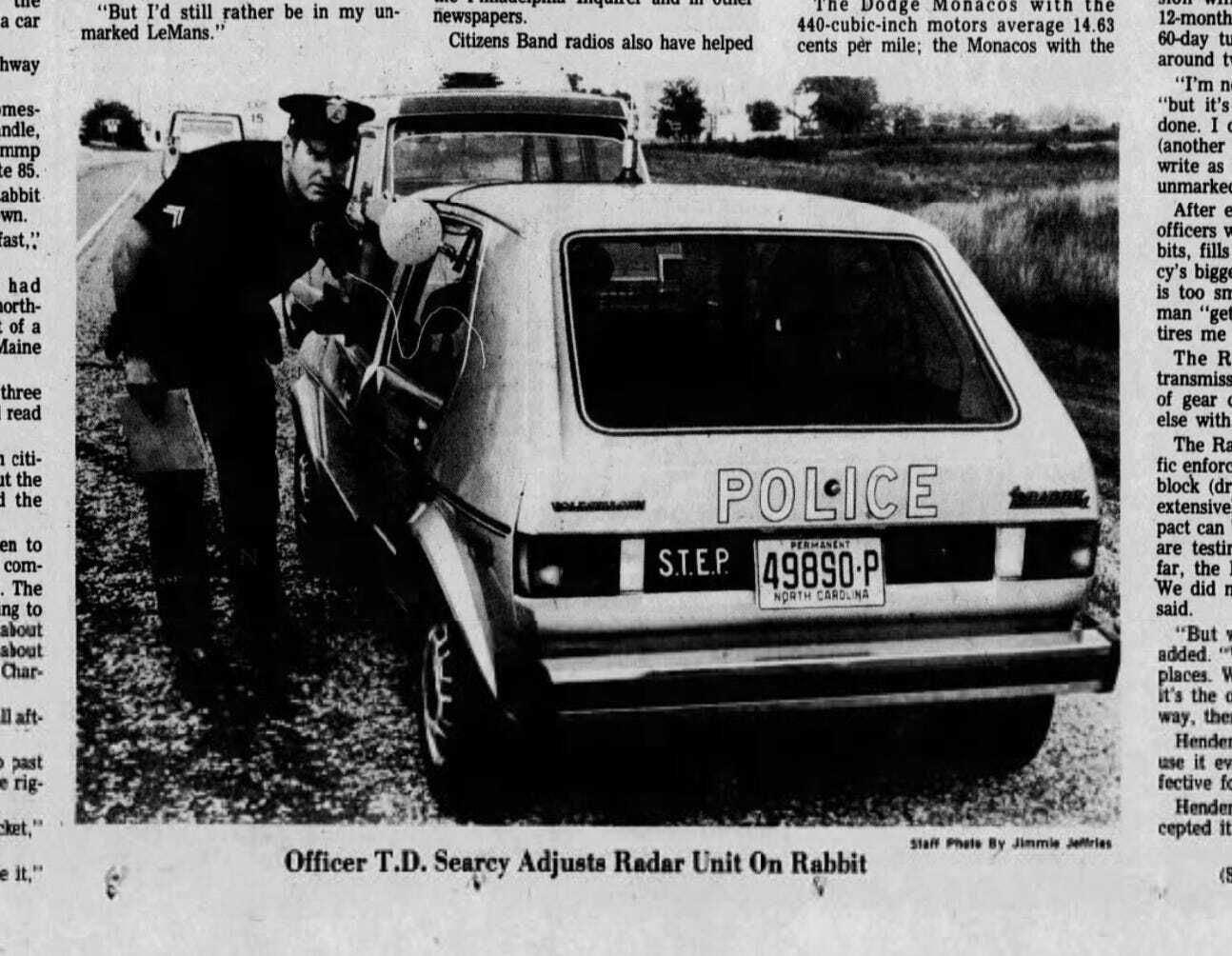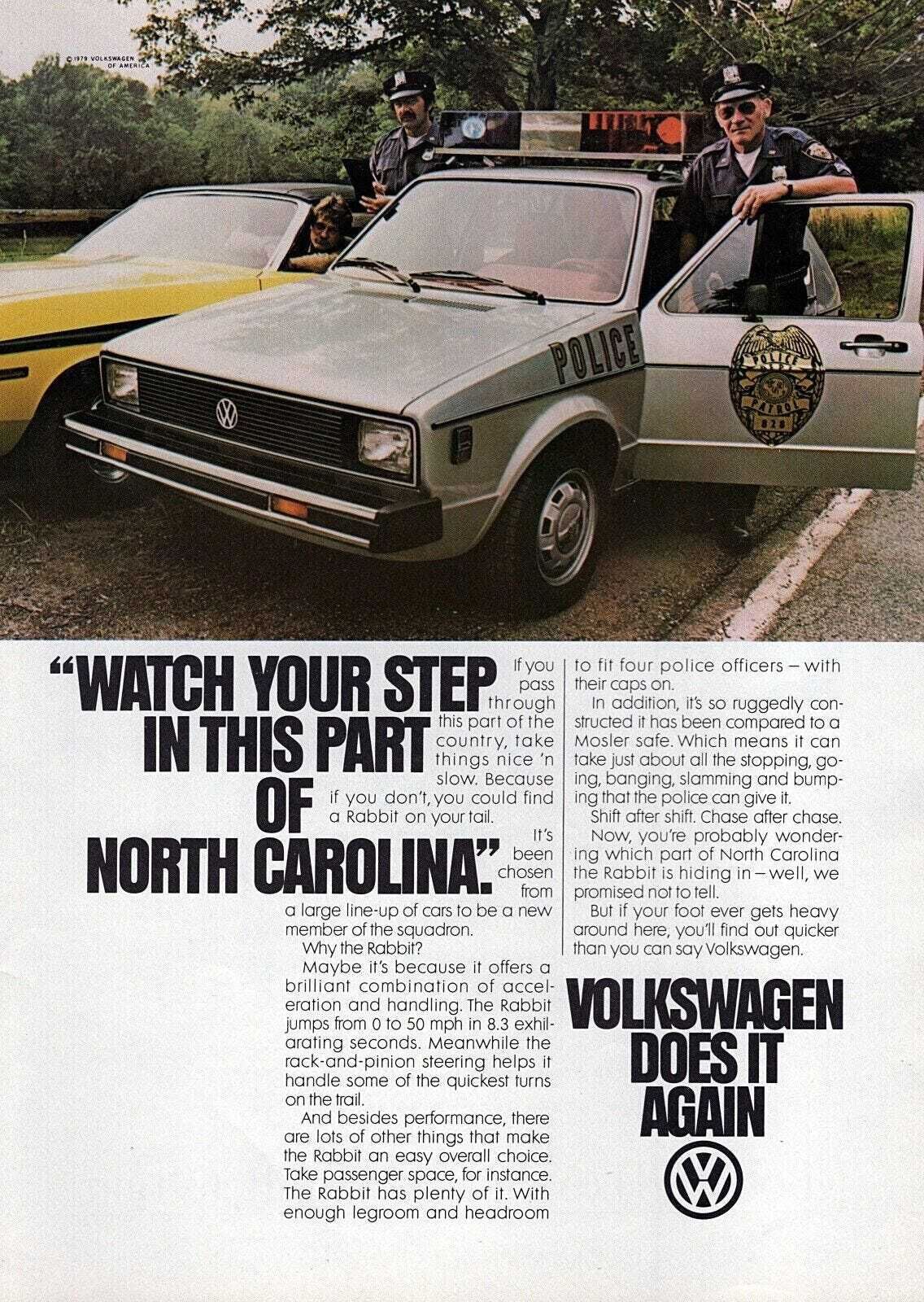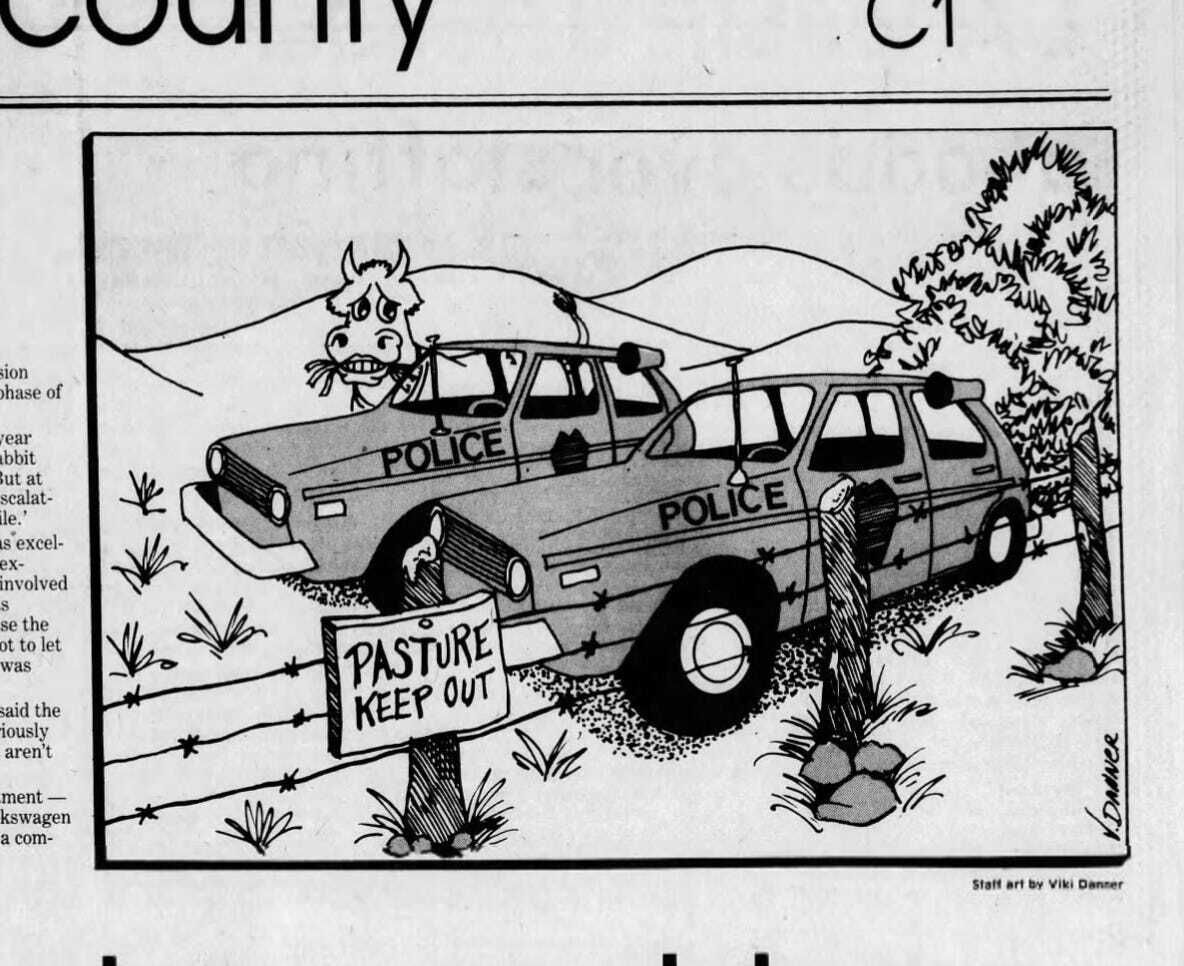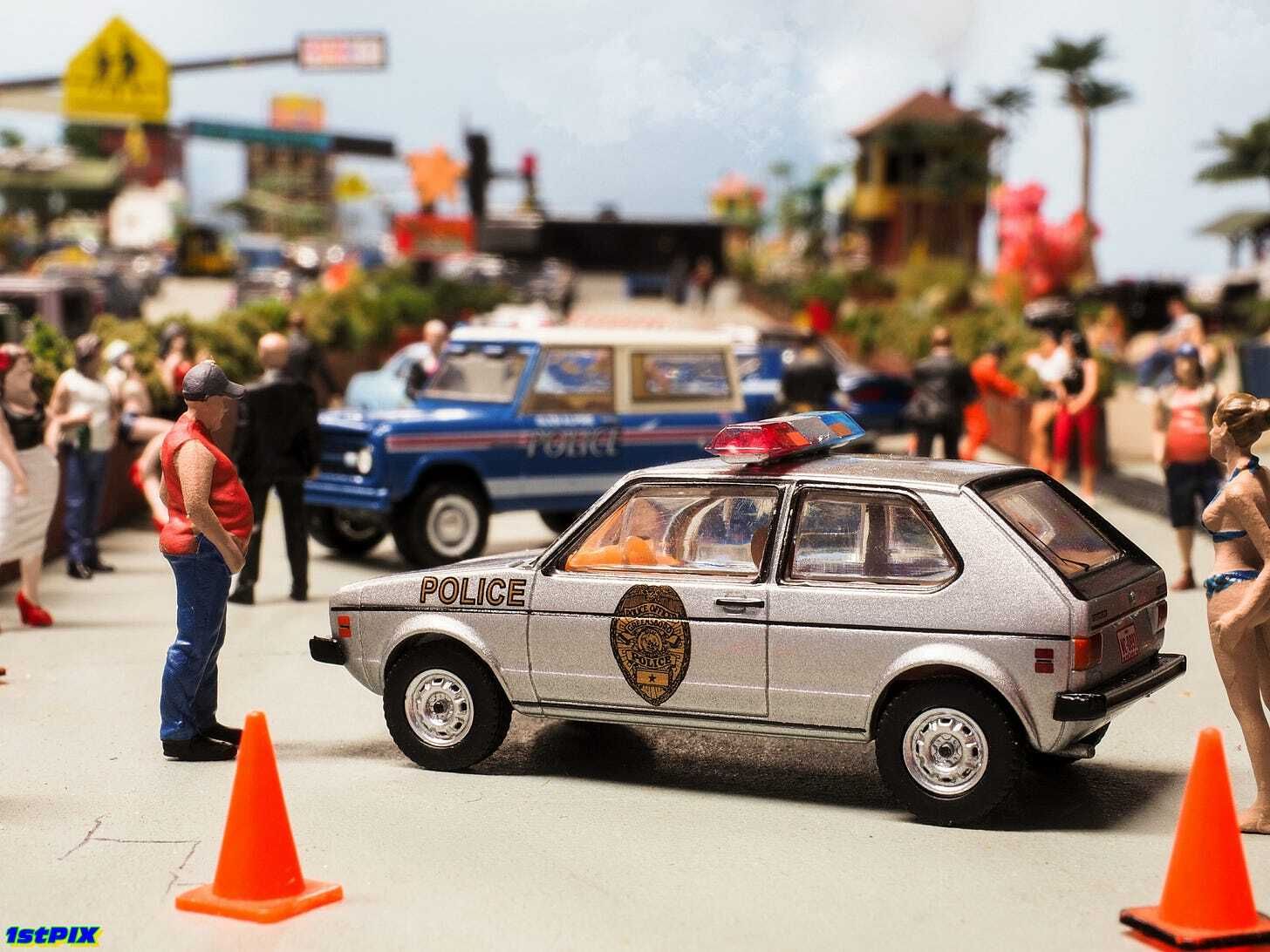Longtime Rabbit Hole reader (and generous Green Bay Packers tailgater) Kelly Fitzgerald sent me this video earlier this summer:
The premise is this: Some dude in a muscle car is speeding through a 45 miles per hour zone in North Carolina. A police car kicks on its lights, rolls up next to the driver, and gets him to pull over. The dude in the sports car looks especially embarrassed, because he’s just been bested by… a Volkswagen Rabbit. You can just watch his masculinity wither away as he incredulously repeats “a Volkswagen Rabbit?!” over and over again.
The original post that Kelly sent was from GMP Performance in Charlotte, a 50-year-old auto shop that soups up German-made cars. It claims to have tricked out a Rabbit for the Greensboro Police Department back in the day. “We took its factory diesel engine to the next level and added GMP Performance springs and sway bars to support the extra power and sharpen its handling. Averaging nearly 40 MPG and plenty of torque, they weren’t stopping until they caught you!”
So, um, did the Greensboro Police Department really use these tiny little cars as their patrol cruisers? And did Volkswagen really make a commercial about it? Did they work? And… whatever happened to those cars, anyway?
The most embarrassing traffic stop ever
On April 13, 1978, a guy in a Dodge Challenger was doing 72 miles per hour along a 45 mile-per-hour stretch of Wendover Avenue in Greensboro. An officer kicked his lights on, but the Challenger didn’t stop. The ensuing chase hit speeds of around 100 miles per hour before the guy finally gave up four miles later. A short item in the Greensboro Daily News noted, with some incredulity, that a “Rabbit Beats Challenger.”

The Greensboro Police had put two Volkswagen Rabbits on traffic duty just two days before. This was their first chase. They won.
The department bought the subcompact cars with state and federal grant money as an experiment. It wanted to see if they could save money by using smaller cars for traffic duty. They didn’t specifically set out to buy Rabbits, though. Instead, the department put out the specs of what they were looking for, and Volkswagen was the only bidder.
Early on, the Rabbits were clearly cheaper to run. They cost about three cents a mile to operate in the first year. The department’s bigger Dodge Monaco cruisers cost about eight. Supervisors were mostly pleased with the early results. They handled well and rarely broke down. “The car has worked excellently,” Lt. W.T. Henderson told the Greensboro Daily News in August 1978.
What they didn’t count on was the publicity from that early traffic stop. News of the chase made its way into U.S. News & World Report and Popular Mechanics and hit newspapers nationwide, including the Philadelphia Inquirer. Soon, other departments were calling up the Greensboro Police and asking about the Rabbits. Department leaders kept telling everyone the same thing: This was an experiment, and while things seemed promising, they had no idea if they’d even be using the Rabbits a year later. “We did not buy it for high speeds,” Henderson stated. The car was most effective within the stop-and-go driving of the city and not on the open highway. “We don’t baby it,” he said. “If you can’t use it everywhere, then it won’t be effective for us.”

The officers who drove it, along with the people they stopped, had a different reaction. “You’ll see more people pointing and laughing at this police car than any other,” squad leader T.D. Searcy told the Daily News. The people who got pulled over by it didn’t think it was all that funny. During a reporter’s ride-along with Searcy, a woman who got a speeding ticket noted that her guard wasn’t up, because the Rabbit just didn’t look like a police car. Another guy told the reporter that he “saw the antenna, saw the radar, and thought that was weird. It was kind of funny when you pulled me.” Searcy said other officers liked the car, but he wasn’t a fan. He didn’t trust it at high speeds. It wasn’t comfortable. And people on CB radios would just rip on the car. They called it the Funny Bunny. “The police must need money bad,” one driver said over the radio. “They can’t buy no big cars.”
“You just watch your step in this part of North Carolina”
During the height of the Funny Bunny’s fame, an ad agency from New York got in contact with the Greensboro Police. They were working on a nationwide campaign for Volkswagen, and asked if they could come to town to film the real Rabbits in action at the site of the chase. The police said no. They weren’t in the business of endorsing products, they said. The agency replied that it’d be making some TV and print ads anyway, and just swapped out “Greensboro” for “North Carolina.”

The cars in the commercials just said “Police,” and the print ad played coy with the location. “Now, you’re probably wondering which part of North Carolina the Rabbit is hiding in,” it reads, “well, we promised not to tell.”
But everybody in Greensboro knew it was them. They were the only department in North Carolina using Rabbits.
Also, they were sort of pissed off about it. “It looks like it is a bit too much of the Hollywood stereotype of the southern policeman,” Greensboro city manager Tom Osborne told the Daily News in 1980. His first reaction to the TV commercial was “not good.” One Volkswagen ad executive noted that they’d gotten positive reaction from other parts of the state and country, but a number of people wrote angry letters because “they feel the commercial portrays the policemen as hicks.” A police major said he was “disappointed.” Another officer said that while he didn’t like the commercial, he was still pleased with how the Rabbits ran. He then backtracked a little. “Please do me a favor,” he told a reporter. “Don’t make that sound like an endorsement.”
So, did the Rabbits … multiply?
The Rabbits’ legendary status didn’t actually save them. By February 1981, the Greensboro Police announced the results of their experiment. The size of the car was the biggest problem. “Small engines are good, but not designed to run as we run them,” Lt. Henderson told the Greensboro Record. Those low operating and maintenance costs—3 cents per mile in the first year—shot way up to 33 cents per mile after three years on the road. They were also not big enough to haul suspects to jail. Other departments that had called with curiosity, like the Royal Canadian Mounted Police, didn’t end up using Rabbits themselves. The two Rabbits did very well on the road (One did get into at least one wreck in 1979 when a driver pulled out in front of it, though nobody was seriously hurt). But alas, they weren’t destined for permanent duty. One of the cars was transferred over to the main city fleet for use by administrators. The other was used for undercover work on the tactical force. The Record mournfully noticed the end of this era with a cartoon.

The cars didn’t last very long in their new jobs. According to notices in the newspaper, the city put one Volkswagen Rabbit up for auction in August 1981, and another one in February 1982. (IMPORTANT NOTE: If you or someone you know happened to buy one of these cars 42 years ago, I am desperate to hear from you!)
The cars themselves didn’t last long, but they do live on in at least one way. In 2019, Greenlight Collectibles made a limited edition die cast car based on the Rabbit from the ad. Some people are using them in their die cast dioramas.

The Rabbit era of the Greensboro Police Department was short lived, but the spirit of the tiny, adorable police car lives on. Ten years ago, the New York Police Department replaced some of its three-wheeled scooters with tiny little Smart Cars, and I can verify that they’re still on active duty (I saw one earlier this year on my trip to New York City). And in an era when souped-up gas guzzling muscle cars are being replaced by hybrids and EVs (Chevy makes an all-electric Blazer pursuit car for police departments now), maybe it’s time to think beyond the Crown Vic and Dodge Challenger and embrace the unusual once again. After all, there is one constant between the 1980s and now: If the police pulled you over with their tiny hatchback, you’d still be embarrassed as hell.
